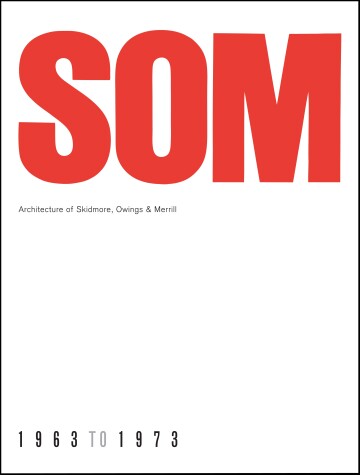Skidmore, Owings & Merrill, founded in 1936, is one of the largest and most influential architecture firms in the world. SOM has long been known for innovation, experimentation, design excellence, and technical mastery, for an abiding interest in the contributions that buildings can make to the life of cities, and for a collaborative approach that extends to all aspects of the design and construction processes. This volume, which presents work from the 1960’s and early 1970’s, reproduces a monograph first published in 1974.
Since the early 1950’s, SOM has ranked among the leading architectural offices in the United States. Buildings such as the office skyscraper of the Lever Brothers Company or the administrative building of the Connecticut General Life Insurance Company have exerted a decisive influence on the history of postwar architecture and have, both by their form and their construction, pointed the way in new directions. SOM has proved that even an enterprise which at present comprises about 1,000 members is able, by teamwork and dedication, to produce results which are equal to those of the great individualists of modern architecture.
This book is dedicated to SOM’s most recent work. The gradual move away from the ideas of the 1950’s, a period which was entirely characterized by the International Style, has not, as was sometimes feared, resulted in a decrease but rather in an increase in architectural quality. To the continued almost unsurpassable technical and organizational discipline has now been added an astonishingly varied form-language. Of those who are moving in completely new directions we should mention, above all, Walter Netsch in Chicago and Edward Bassett in San Francisco. Netsch developed a multi-axial ground-plan geometry which makes it possible to use identical elements which are easy to mass-produce in the construction of extremely complex buildings which can be extended on the principle of cellular structures; Bassett is especially concerned with overcoming the isolation of individual buildings which is a heritage of the International Style period. But even those who have carried on along the principles of the 1950’s have not been simply marking time. On the contrary, they subject these principles to new interpretations and continue to develop them consequentially, either toward an intensification of the architectural expression (Gordon Bunshaft, Roy Allen) or toward a refinement of the construction methods (Bruce Graham, Fazlur Khan). Bunshaft has, in recent years, distinguished himself above all in his response to the challenge of an increased desire for symbolism in architecture; the names Graham and Khan are synonymous with the process of forming the external framework of a building as a self-supporting tube, a development which has opened up completely new perspectives in the field of skyscraper construction.
The building and projects included in this book combine to produce an impressive survey of the activity of the past ten years. All the examples are provided with comprehensive commentaries and, where necessary, documented with attention to details. In his extensive introduction, Arthur Drexler explains the social and architectural relevance of SOM’s work and subjects it to a critical appraisal.
- ISBN10 1580932215
- ISBN13 9781580932219
- Publish Date 17 November 2009
- Publish Status Active
- Out of Print 20 May 2017
- Publish Country US
- Imprint The Monacelli Press
- Format Hardcover
- Pages 264
- Language English
- URL https://penguinrandomhouse.com/books/isbn/9781580932219
